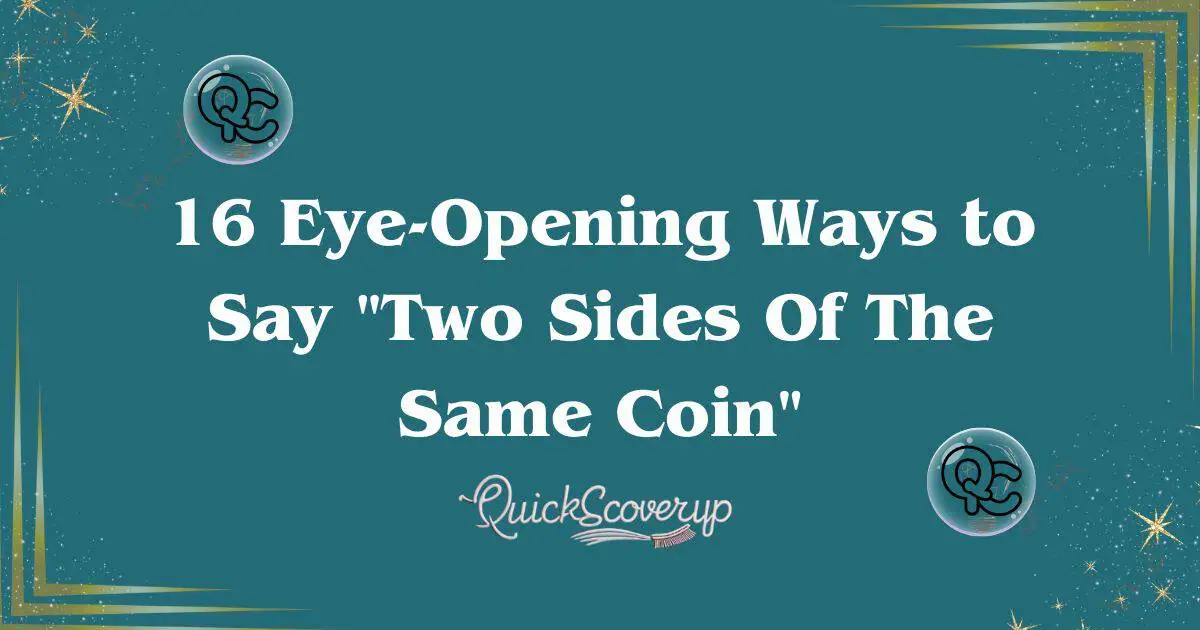“Two sides of the same coin” is a popular phrase used to describe two different aspects of a single issue or concept. It suggests that seemingly opposite things are actually closely related or interdependent. This expression highlights the duality present in many situations, reminding us that contrasting viewpoints can often be part of a larger, unified whole.
Have you ever felt like you’re stuck in a language rut, using the same old expressions over and over? It’s time to shake things up and expand your vocabulary. Imagine having a toolbox full of fresh, eye-opening ways to express familiar ideas. That’s exactly what we’re offering in this article.
We’re about to explore 16 alternative ways to say “two sides of the same coin.” These phrases will help you communicate more effectively and add flair to your conversations. From “different perspectives on the same issue” to “balance of opposites,” each alternative offers a unique angle on the concept of duality. Get ready to breathe new life into your language!
Synonyms for “Two Sides Of The Same Coin”
When we talk about “two sides of the same coin,” we’re referring to things that seem different but are actually closely related. This concept pops up in all areas of life, from personal relationships to global politics. Having different ways to express this idea can make your communication more engaging and precise. It’s like having a toolbox full of different tools each phrase is suited for a specific situation.
Using these alternatives can also show that you have a good grasp of language. It demonstrates your ability to express complex ideas in various ways. This skill is valuable in both personal and professional settings. As we go through these alternatives, think about how you might use them in your own life. You might be surprised at how often these concepts come up in everyday conversations.
Here is different synonyms for “two sides of the same coin”
- Different Perspectives on the Same Issue
- Two Views of the Same Situation
- Opposing Yet Complementary
- Different Angles on the Same Topic
- Contrasting But Related
- Divergent Yet Connected
- Varied Approaches to the Same Concept
- Different Takes on the Same Matter
- Diverse Opinions on the Same Subject
- Alternative Views of the Same Problem
- Different Takes on the Same Issue
- Dual Perspectives on a Single Topic
- One and the same
- Bound together
- Symbiotic relationship
- Balance of opposites
1. Different Perspectives on the Same Issue
When we talk about “different perspectives on the same issue,” we’re acknowledging that people can look at the same problem in various ways. This phrase is particularly useful when discussing complex topics where there’s no clear right or wrong answer.
For Example
In the debate about remote work, employees and employers often have different perspectives on the same issue. Employees might focus on work-life balance, while employers might be more concerned about productivity and team cohesion.
2. Two Views of the Same Situation
“Two views of the same situation” emphasizes that people can interpret events differently based on their background, experiences, or biases. This phrase is often used in legal contexts.
For Example
In a courtroom, the prosecution and defense present two views of the same situation, each interpreting the evidence to support their case. It’s a reminder that truth can be subjective and that understanding different viewpoints is crucial for fair judgment.
3. Opposing Yet Complementary
The phrase “opposing yet complementary” captures the idea that things can be different and still work together harmoniously. This concept is often seen in nature.
For Example
Predators and prey are opposing yet complementary forces in an ecosystem. While they seem to be in conflict, they actually help maintain the balance of nature.
Each plays a crucial role in the other’s existence, demonstrating how opposition can lead to a kind of harmony.
4. Different Angles on the Same Topic
When we talk about “different angles on the same topic,” we’re highlighting how various approaches can provide a more comprehensive understanding. This phrase works well in academic or professional settings.
For Example
In a brainstorming session, team members might bring different angles on the same topic, each contributing unique insights based on their expertise.
This diversity of thought often leads to more innovative solutions and a deeper understanding of complex issues.
5. Contrasting But Related
“Contrasting but related” emphasizes that things can be different yet still connected. This phrase is often used in pop culture analysis. Superhero movies frequently feature heroes and villains who are contrasting but related.
For Example
Think of Batman and the Joker they’re opposites in many ways, but they’re also deeply connected, each defining the other’s existence.
This relationship adds depth to the story and keeps audiences engaged.
6. Divergent Yet Connected
The phrase “divergent yet connected” highlights how things can move in different directions while still maintaining a fundamental link. In the business world, we often see companies with divergent yet connected strategies.
For Example
Apple and Microsoft have taken very different approaches to technology and marketing.
Yet, their rivalry and innovations have shaped the entire tech industry, demonstrating how divergent paths can still be deeply interconnected.
7. Varied Approaches to the Same Concept
When we talk about “varied approaches to the same concept,” we’re emphasizing the diversity in problem-solving methods. This phrase is particularly relevant in education.
For Example
Teachers often use varied approaches to the same concept to reach students with different learning styles. Some students might grasp a math concept through visual representations, while others might understand it better through hands-on experiments.
By using varied approaches, teachers can ensure that more students grasp the core concept.
8. Different Takes on the Same Matter
“Different takes on the same matter” is a casual way to acknowledge diverse opinions. This phrase is perfect for describing social media discussions.
For Example
On Twitter, you’ll often see threads showcasing different takes on the same matter, whether it’s a current event, a new movie, or a controversial statement.
These varied perspectives can broaden our understanding and challenge our assumptions, showing the value of diverse viewpoints in public discourse.
9. Diverse Opinions on the Same Subject
The phrase “diverse opinions on the same subject” emphasizes the value of multiple viewpoints in understanding complex issues.
For Example
This is often seen in political contexts. Town hall meetings bring out diverse opinions on the same subject, allowing citizens to voice their concerns and ideas.
These varied perspectives can help policymakers understand the full impact of their decisions and create more inclusive solutions.
10. Alternative Views of the Same Problem
“Alternative views of the same problem” encourages us to think creatively and consider unconventional solutions.
For Example
This phrase is often used in scientific contexts. Quantum physics offers alternative views of the same problem in understanding reality. It challenges our classical understanding of physics and opens up new possibilities for technological advancements.
This phrase reminds us that sometimes, revolutionary progress comes from looking at old problems in entirely new ways.
11. Different Takes on the Same Issue
“Different takes on the same issue” is a versatile phrase that acknowledges the variety of opinions people can have on a single topic. It’s particularly useful when discussing complex subjects that don’t have clear-cut answers.
For Example
In the debate about social media regulation, users, tech companies, and lawmakers often have different takes on the same issue.
This phrase reminds us that understanding multiple perspectives is crucial for a well-rounded view of any complex topic.
12. Dual Perspectives on a Single Topic
“Dual perspectives on a single topic” balances the ideas of unity and diversity. This phrase is often used in literary analysis.
For Example
Shakespeare’s Romeo and Juliet shows two sides of love. It looks at love through the eyes of the lovers, their families, and society.
The play reveals how one theme can be seen in many different ways.
13. One and the Same
The phrase “one and the same” explores the idea of underlying unity beneath apparent differences. This concept is often discussed in philosophical or religious contexts.
For Example
Some argue that all religions are one and the same at their core, sharing fundamental values of compassion and ethical behavior.
This perspective encourages us to look beyond surface differences and find common ground.
14. Bound Together
“Bound together” emphasizes the inseparable nature of seemingly different things. This phrase is often used in historical or geopolitical discussions.
For Example
The fates of Europe and America have been bound together since World War II, with their economies, politics, and cultures deeply intertwined.
This phrase reminds us of the interconnectedness of our global society and the ripple effects of major events.
15. Symbiotic Relationship
A “symbiotic relationship” refers to a mutually beneficial connection between different entities. This term is often used in biology but can apply to many other fields.
For Example
Bees and flowers have a symbiotic relationship, each depending on the other for survival.
This phrase helps us understand how seemingly different things can be deeply interdependent, contributing to a larger system or ecosystem.
16. Balance of Opposites
The “balance of opposites” captures the yin-yang concept of complementary forces. This phrase is often used in discussions about lifestyle and personal development.
For Example
Work and play form a balance of opposites in a healthy life. While they seem contradictory, both are necessary for overall well-being.
This phrase reminds us that opposites can create harmony when in the right balance.
Conclusion
These 16 alternatives to “two sides of the same coin” offer a rich vocabulary for expressing the concept of duality and interconnectedness. By incorporating these phrases into your communication, you can express ideas more precisely and engagingly. Remember, language is a powerful tool. The more diverse your linguistic toolkit, the better you can articulate complex ideas and connect with others.
FAQ’s
1. What does “Two Sides of the Same Coin” mean?
It refers to two things that are closely related yet opposite. Despite their differences, both are part of the same issue or concept.
2. How can I creatively express “Two Sides of the Same Coin”?
You could say, “They’re different paths to the same destination,” or “They share the same roots but grow in opposite directions.”
3. Is there a metaphor for “Two Sides of the Same Coin”?
Yes, “Yin and Yang” or “Light and Shadow” can convey the idea of interconnected opposites.
4. Can I use “Two Sides of the Same Coin” in casual conversation?
Absolutely. It’s a great way to point out how two opposing things are related, like risk and reward.
5. How do I explain this phrase in simple terms?
It means two things are different but connected, like two halves of a whole. One can’t exist without the other.
Also Read
20 Fresh Ways to Say “I Appreciate Your Interest”
25 Other Creative Ways to Say “Hope to See You Soon”
20 Other Ways to Say “Happy Sabbath” (With Examples)
25 Other Ways to Say “Thank You for Clarifying”











